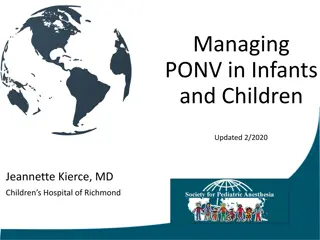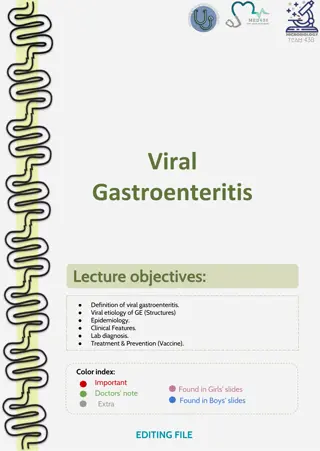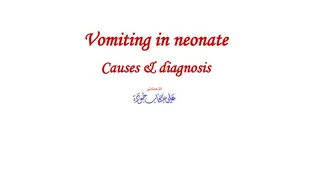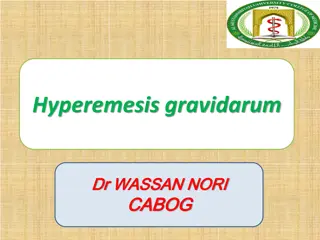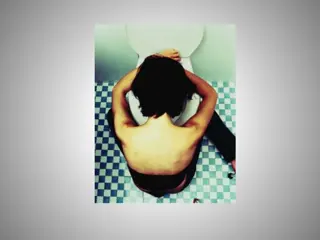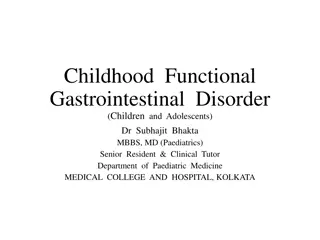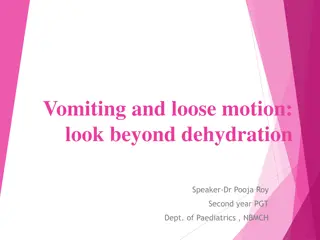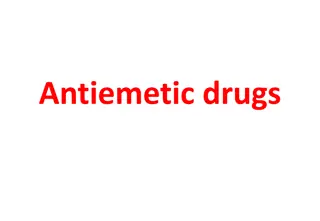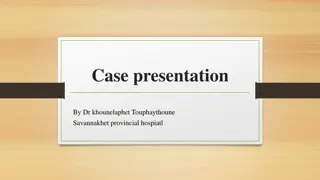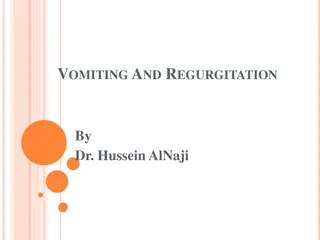
Pediatric Vomiting: Causes, Diagnosis, and Management
Learn about pediatric vomiting, including definitions of vomiting and regurgitation, differential diagnosis in neonates, common causes such as infantile GER and pyloric stenosis, and the role of metabolic disorders and infections. Discover when to consider central nervous system causes for chronic vomiting and when evaluation for bowel obstruction is necessary. This comprehensive guide provides valuable insights for parents and caregivers to understand and address pediatric vomiting issues effectively.
Download Presentation

Please find below an Image/Link to download the presentation.
The content on the website is provided AS IS for your information and personal use only. It may not be sold, licensed, or shared on other websites without obtaining consent from the author. If you encounter any issues during the download, it is possible that the publisher has removed the file from their server.
You are allowed to download the files provided on this website for personal or commercial use, subject to the condition that they are used lawfully. All files are the property of their respective owners.
The content on the website is provided AS IS for your information and personal use only. It may not be sold, licensed, or shared on other websites without obtaining consent from the author.
E N D
Presentation Transcript
Dr . Fariborzi Pediatric Gastroentrologist
Definition Vomiting : is a coordinated, sequential series of events that leads to forceful oral emptying of gastric contents. Vomiting is usually preceded by nausea, followed by forceful gagging and retching.
Regurgitation : effortless and not preceded by nausea
Differential Diagnosis In neonates congenital obstructive lesions should be considered. Allergic reactions to formula also are common in the first 2 months of life.
Infantile GER occurs in most infants and can be large in volume, but is effortless and these infants do not appear ill.
Pyloric stenosis occurs in the first month of life and is characterized by steadily worsening forceful vomiting which occurs immediately after feedings. Prior to vomiting a distended stomach often with visible peristaltic waves is often seen. Pyloric stenosis is more common in male infants, and there may be a positive family history. Other obstructive lesions, such as intestinal duplication cysts, atresias, webs, and midgut malrotation must be ruled out.
Metabolic disorders organic acidemias, galactosemia, urea cycle defects, etc.) can cause vomiting in infants
In older children with acute vomiting, viral illnesses are common. Other infections, especially streptococcal pharyngitis, urinary tract infections, and otitis media, commonly result in vomiting.
When vomiting is chronic, central nervous system (CNS) causes (increased intracranial pressure, migraine) must be considered
When abdominal pain or bilious emesis accompanies vomiting, evaluation for bowel obstruction, peptic disorders, and appendicitis must be immediately initiated
Assessment Physical examination include assessment of the child's hydration status, including examination of capillary refill, moistness of mucous membranes, and skin turgor . The chest should be auscultated for evidence of pulmonary involvement. The abdomen must be examined carefully for distention, organomegaly, bowel sounds, tenderness, and guarding. A rectal examination and testing stool for occult blood should be performed.
Differential Diagnosis of Vomiting by Historical Features Viral gastroenteritis Fever, diarrhea, sudden onset, absence of pain Gastroesophageal reflux Effortless, not preceded by nausea chronic Hepatitis Jaundice, history of exposure
Extragastrointestinal Otitis media: Fever, ear pain Urinary tract infection: Dysuria, unusual urine odor, frequency, incontinence Pneumonia: Cough, fever, chest discomfort
Allergic Milk or soy protein intolerance (infants): Associated with particular formula or food, blood in stools Other food allergy (older children)
Peptic ulcer or gastritis Epigastric pain, blood or coffee-ground material in emesis pain relieved by acid blockade
Appendicitis: Fever, abdominal pain migrating to the right lower quadrant, tenderness
Anatomic obstruction : Intestinal atresia: Neonate, usually bilious,polyhydramnios Midgut malrotation: Pain, bilious vomiting, gastrointestinal bleeding, shock Intussusception: Colicky pain, lethargy, vomiting, currant jelly stools, mass occasionally
Duplication cysts: Colic, mass Pyloric stenosis : Nonbiliousvomiting, postprandial, <4 mo old, hunger
Bacterial gastroenteritis: Fever, often with bloody diarrhea
Central nervous system Hydrocephalus : Large head, altered mental status Meningitis: Fever, stiff neck Migraine syndrome: Attacks scattered in time, relieved by sleep; headache Cyclic vomiting syndrome : Similar to migraine, usually no headache Brain tumor: Morning vomiting, accelerating over time, headache, diplopia
Motion sickness: Associated with travel in vehicle Labyrinthitis : Vertigo Metabolic disease : Presentation early in life, worsens when catabolic or with exposure to substrate Pregnancy: Morning, sexually active, cessation of menses Drug reaction or side effect: Associated with increased dose or new medication Cancer chemotherapy: Temporally related to administration of chemotherapeutic drugs
Laboratory evaluation 1- serum electrolytes 2- tests of renal function 3-complete blood count 4- amylase 5- lipase 6-liver function tests. Additional testing may be required immediately when history and examination suggest a specific etiology.
Ultrasound is useful to look for pyloric stenosis, gallstones, renal stones, hydronephrosis, biliary obstruction, pancreatitis, appendicitis, malrotation, intussusception, and other anatomic abnormalities. CT may be indicated to rule out appendicitis or to observe structures that cannot be visualized well by ultrasound. Barium studies can show obstructive or inflammatory lesions of the gut and can be therapeutic, as in the use of contrast enemas for intussusception
Treatment Treatment of vomiting needs to address the consequences and causes of the vomiting. Dehydration must be treated with fluid resuscitation. This can be accomplished in most cases with oral fluid- electrolyte solutions, but IV fluids are commonly required. Electrolyte imbalances should be corrected by appropriate choice of fluids. Underlying causes should be treated when possible
The use of antiemetic medications is controversial. These drugs should not be prescribed until the etiology of the vomiting is known and then only for severe symptoms. Phenothiazines, such as prochlorperazine, may be useful for reducing symptoms in food poisoning and motion sickness. Their side effect profile must be considered carefully, and the dose prescribed should be conservative.
Anticholinergics, such as scopolamine, and antihistamines, such as dimenhydrinate, are useful for the prophylaxis and treatment of motion sickness. Drugs that block serotonin 5-HT3receptors, such as ondansetron and granisetron, are used for viral gastroenteritis, and can improve tolerance of oral rehydration therapy. They are clearly helpful for chemotherapy-induced vomiting, often combined with dexamethasone.
No antiemetic should be used in patients with surgical emergencies or when a specific treatment of the underlying condition is possible. Correction of dehydration, ketosis, and acidosis by oral or intravenous rehydration is helpful to reduce vomiting in most patients with viral gastroenteritis
Gastroesophageal Reflux Etiologyand Epidemiology Gastroesophageal reflux (GER) is defined as the effortless retrograde movement of gastric contents upward into the esophagus or oropharynx. In infancy, GER is not always an abnormality. Physiological GER ( spitting up ) is normal in infants younger than 8-12 months old. Nearly half of all infants are reported to spit up between 2 and 4 months of age. Infants who regurgitate meet the criteria for physiological GER so long as they maintain adequate nutrition and have no signs of respiratory complications or esophagitis. Contributing factors of infantile GER include liquid diet; horizontal body position; short, narrow esophagus; small, noncompliant stomach; frequent, relatively large-volume feedings; and an immature lower esophageal sphincter (LES). As infants grow, they spend more time upright, eat more solid foods, develop a longer and larger diameter esophagus, have a larger and more compliant stomach, and experience lower caloric needs per unit of body weight. As a result, most infants stop spitting up by 9-12 months of age.
Gastroesophageal reflux disease (GERD) occurs when GER leads to troublesome symptoms or complications such as poor growth, pain, or breathing difficulties. GERD occurs in a minority of infants but is often implicated as the cause of fussiness. GERD is seen in fewer than 5% of older children. In older children, normal protective mechanisms against GER include antegradeesophageal motility, tonic contraction of the LES, and the geometry of the gastroesophageal junction. Abnormalities that cause GER in older children and adults include reduced tone of the LES, transient relaxations of the LES, esophagitis (which impairs esophageal motility), increased intraabdominal pressure, cough, respiratory difficulty (asthma or cystic fibrosis), and hiatal hernia.
Clinical Manifestations Cough Hoarseness Wheezing Abdominal Pain Failure to Thrive
The presence of GER is easy to observe in an infant who spits up. In older children, the refluxate is usually kept down by reswallowing, but GER may be suspected by associated symptoms, such as heartburn, cough, epigastric abdominal pain, dysphagia, wheezing, aspiration pneumonia, hoarse voice, failure to thrive, and recurrent hiccoughs or belching. In severe cases of esophagitis, there may be laboratory evidence of anemiaand hypoalbuminemia secondary to esophageal bleeding and inflammation. When esophagitis develops as a result of acid reflux, esophageal motility and LES function are impaired further, creating a cycle of reflux and esophageal injury
Laboratory and Imaging Studies A clinical diagnosis is often sufficient in children with classic effortless regurgitation and no complications. Diagnostic studies are indicated if there are persistent symptoms or complications or if other symptoms suggest the possibility of GER in the absence of regurgitation. A child with recurrent pneumonia, chronic cough, or apneic spells without overt emesis may have occult GER. A barium upper gastrointestinal (GI) series helps to rule out gastric outlet obstruction, malrotation, or other anatomical contributors to GER. Because of the brief nature of the examination, a negative barium study does not rule out GER, nor does it rule it in as it is normal to have some reflux into the esophagus many times per day. A 24-hour esophageal pH probe monitoring uses a pH electrode placed transnasally into the distal esophagus, with continuous recording of esophageal pH. Data typically are gathered for 24 hours and analyzed for the number and temporal pattern of acid reflux events. Esophageal impedance monitoring records the migration of electrolyte-rich gastric fluid in the esophagus. Endoscopy is useful to evaluate for esophagitis, esophageal stricture, and anatomical abnormalities.
Treatment In otherwise healthy young infants, no treatment is necessary. For infants with complications of GER, an H2 blocker or proton-pump inhibitor may be offered ,but these have shown little benefit in infants with uncomplicated GER and/or fussiness. Prokinetic drugs, such as metoclopramide, occasionally are helpful by enhancing gastric emptying and increasing LES tone, but they are seldom effective and may lead to complications. When severe symptoms persist despite medication, or if lifethreatening aspiration is present, surgical intervention may be required. Fundoplication procedures, such as the Nissen operation, are designed to enhance the antireflux anatomy of the LES. In children with a severe neurological defect who cannot tolerate oral or gastric tube feedings, placement of a feeding jejunostomy may be considered as an alternative to fundoplication. In older children, lifestyle changes should be discussed, including cessation of smoking, weight loss, not eating before bed or exercise, and limiting intake of caffeine, carbonation, and high-fat foods. However, proton pump inhibitor therapy is more effective in reducing symptoms and supports healing.
Cyclic Vomiting Syndrome Etiologyand Epidemiology Cyclic vomiting syndrome (CVS) presents with intermittent episodes of prolonged nausea and vomiting with periods of health in between. It can occur at any age but is diagnosed most frequently in preschool to school-age children. It is thought to be a migraine variant; many patients have a positive family history of migraines, and some with CVS will eventually develop migraine headaches. Triggers to an episode often include viral illnesses, lack of sleep, stressful or exciting events (holidays, birthdays, vacations), physical exhaustion, and menses
Clinical Manifestations Episodes can start at any time but will often start in the early morning hours. Episodes are similar to each other in timing and duration. Repetitive vomiting can last hours to days. Patients can also have abdominal pain, diarrhea, and headaches. Those affected are typically pale, listless, and prefer to be left alone. They may have photo- or phonophobia.
Laboratory and Imaging Studies There are no specific tests for CVS, which is diagnosed based on the history and the exclusion of other disorders. Diagnoses that should be considered include malrotationwith intermittent volvulus, uteropelvic junction (UPJ) obstruction, EoE, intracranial mass lesions, and metabolic disorders.
Treatment For the acute episode, supportive treatment includes hydration; dark, quiet environment; and antiemetics such as ondansetron. In addition, abortive therapy using antimigraine medications such as NSAIDs and triptanscan be used. For those with frequent or prolonged episodes, prophylactic therapy can be used, such as cyproheptadine, tricyclicantidepressants, beta blockers, or topiramate.



